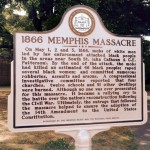This past summer, I finally read Stephen Ash’s book, A Massacre In Memphis, and was stunned. I was not stunned because of what I learned about the nature of the atrocities perpetrated against the African-American community in 1866. Nor was I stunned that no one was prosecuted for the offenses although the nation responded to the extensive news of the massacre with outrage. I really wasn’t even stunned that it was local law enforcement who led the mobs of white men who attacked black Memphians on May 1, 2 and 3, 1866.
Instead, what shocked me the most was that although I was born and raised right here in Memphis, I didn’t remember previously being told about this important event in our nation’s history. It was inconceivable to me that the solid education that I received here would have omitted an event that many believe significantly contributed to the congressional vote to propose to the states the 14th Amendment to our United States Constitution in June 1866. Although it took another two years for enough states to ratify the 14th Amendment, it is clear that the 1866 Memphis Massacre spurred Congress to act boldly in spite of significant opposition from our fellow Tennessean, President Andrew Johnson. In fact, just one week after the massacre ended, Rep. Thaddeus Stevens of Pennsylvania argued to his colleagues in Congress, “Let not these friends of secession sing to me their siren song of peace and good will until they can stop my ears to the screams and groans of the dying victims at Memphis.”
When I discovered that no historical marker had been erected to honor the victims of the massacre whose sacrifices helped our nation to realize that citizenship by birth; the privileges and immunities of citizenship; due process and equal protection of the laws are all worthy of constitutional protection, I decided to remedy that omission before the 150th anniversary of the Memphis Massacre. I immediately found a ready partner in the Memphis NAACP and later in the National Park Service.
The initial application for the historical marker was submitted to  the Tennessee Historical Commission in July 2015 and later approved by its Historical Monuments and Markers Committee with one dissenting vote. However, the dissenter substantially rewrote the proposed marker text and carried his objections to the October meeting of the full commission. The full commission decided to adopt the dissenter’s substantial rewrite over the objections of the Memphis NAACP. The Memphis NAACP lodged an official written objection to the Commission’s actions along with letters of support from two noted historians—Dr. Beverly Bond and Dr. Stephen Ash.
the Tennessee Historical Commission in July 2015 and later approved by its Historical Monuments and Markers Committee with one dissenting vote. However, the dissenter substantially rewrote the proposed marker text and carried his objections to the October meeting of the full commission. The full commission decided to adopt the dissenter’s substantial rewrite over the objections of the Memphis NAACP. The Memphis NAACP lodged an official written objection to the Commission’s actions along with letters of support from two noted historians—Dr. Beverly Bond and Dr. Stephen Ash.
Several months later, we were notified that during its upcoming February meeting, the full commission would be asked to reconsider certain portions of the text that it had previously approved in October. On February 19, 2016, the state historical commission approved a modified version of the text that it had approved during the October 2015 meeting. In a last minute decision, it also decided to add the subtitle, “The Memphis Massacre” to the historical marker that it continued to title, “The Memphis Race Riot of 1866.” Additionally, the text of the marker would continue to refer to the attack as a riot and to the attackers as rioters; thereby, failing to recognize the true gravity of what happened during the attacks on black Memphians in May 1866. After meeting with consulting historians, the Memphis NAACP decided to oppose the decision to title the marker, “The Memphis Race Riot of 1866” and the decision to refer to the attackers as rioters.
The importance of the title for this historical marker is inescapably wrapped in the complex history of the post-Civil War Reconstruction Era. The opposition to calling this event a mere riot should be examined in light of the false reports that indicated that the black residents of South Memphis were rioting and in light of the local pro-Confederate newspapers’ rushed attempts to blame the massacre entirely on black people and the impoverished recent Irish immigrant community, rather than sharing the blame with ex-Confederates who hoped to soon be re-enfranchised if President Johnson had his way. My opposition to the term “riot” takes into account that the majority report of the 1866 Congressional Select Committee that was sent to investigate the “riots” plainly states, “The proportions of what is called the “riot,” but in reality the massacre, proved to be far more extended, and the circumstances surrounding it of much greater significance, than the committee had any conception of before they entered upon their investigation.”
Those who oppose the title “riot” find it hard to ignore that the attacks conveniently occurred just one day after the much anticipated mustering out of service of a regiment of black Union soldiers stationed in nearby Fort Pickering. After the Third Heavy Artillery regiment of black soldiers had been disbanded and the soldiers stripped of official authority, they were unable to protect civilian black Memphians from the ensuing attacks.
I believe that the most gaping wounds of injustice can be healed with a dose of justice. Although 150 years may erase the community’s memory of the massacre, the untreated resulting emotional pain gets passed down through the generations. At this point, the only thing we have left to offer the victims of the massacre is a type of moral justice—historical justice.
I’m convinced that healing for our community must begin with the acknowledgment that a wound exists and with an examination of the extent of the wound. That was the theory behind the “truth commissions” in South Africa. It is time for us to provide an opportunity for our community to publicly acknowledge that what happened in the 1866 Memphis Massacre was wrong and to honor the resiliency, strength and courage of the African American community that survived the massacre. These forefathers and foremothers refused to give up their goals of becoming educated, of obtaining good jobs and of having freedom of worship, and in doing so, demonstrated the true American spirit that should inspire us all to be better citizens today. They deserve a sign that accurately reflects and reminds us of what they endured.
On May 20-21, 2016, the University of Memphis will host “Memories of a Massacre: Memphis in 1866, a Symposium Exploring Slavery, Emancipation, and Reconstruction.” If you cannot attend the symposium, please follow us on Twitter @MemphisMassacre. We will also live tweet the event using #MemphisMassacre1866. You can also like us on Facebook.
 Phyllis Aluko is an Assistant Public Defender for Shelby County and a member of the Memphis Bar Foundation Board of Directors.
Phyllis Aluko is an Assistant Public Defender for Shelby County and a member of the Memphis Bar Foundation Board of Directors.

Thank you, Phyllis for your grit and determination in the face of resistance. The Memphis Massacre is a part of our national historic landscape, and no amount of white washing can erase its importance or the sacrifices of its victims.